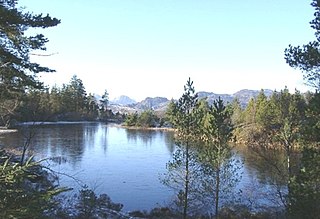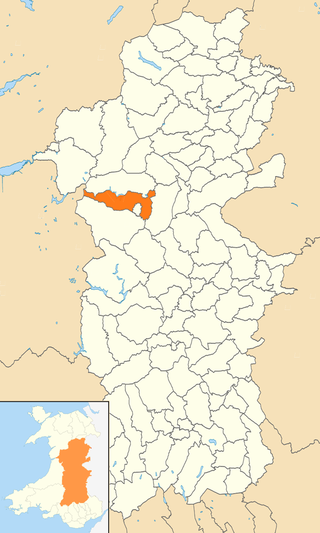
Hafren Forest lies north-west of Llanidloes, an ancient market town in Mid Wales.

Hafren Forest lies north-west of Llanidloes, an ancient market town in Mid Wales.
The forest covers around 40 square kilometres (15 square miles), and consists mainly of pine and spruce trees. It takes its name from the Afon Hafren (Welsh for ' River Severn ') which rises in a deep peat bog approximately 800 metres (0.5 miles) outside western boundary of the forest, high on the slopes of Pumlumon, the highest mountain in Mid Wales.
The forest, planted in 1937, is continually changing with felling and planting of trees. The forest is also home to Bronze Age copper and lead mines, [1] most notably "Nant yr Eira" and possibly "Nant yr Rickett".
The creation of the forest in 1937 involved the purchase of twelve upland sheep farms, including "Rhyd y Benwch" which is now the location of a car park and picnic area. [2]
Although the farms were not left derelict, they could not provide enough accommodation for forest workers in this sparsely-populated area. At first, with the initial small size of the forest, enough workers could be found locally. Later, workers were transported from Llanidloes. This was unsustainable, and in 1948, the Forestry Commission decided to build a village near Staylittle, to house forestry workers. They employed an eminent architect, T. Alwyn Lloyd of Cardiff, to produce plans for a village that would eventually comprise eighty houses, a village shop, school and hall. As a first development, twenty houses were built on the site, with eight more a few miles away: these provided accommodation for half the workers. Construction began in 1949, with the first houses being occupied in 1951. The water supplies for the village, known as Llwyn-y-gog (or Llwynygog), were provided by damming of a nearby stream. [3] [4]

Although the forest still produces timber for Natural Resources Wales, it has also developed as a wildlife habitat and as a tourist attraction. The red kite is seen in the area, along with many other birds, plants and animals. There are numerous footpaths, and many bridleways that are popular for mountain biking and horse riding. Published walks include "The Source of The Severn", "Severn Breaks its Neck" and "The Blaenhafren Falls". [5]
The Wye Valley Walk finishes at Rhyd y Benwch in the forest. [6]
A quarry in the forest is used "explosion studies" by Aberystwyth University's Combustion Physics Group. This quarry had previously been used by British Aerospace.
The forest is a popular location for many motocross and 4x4 championships and rally events.
The forest is regularly used as a stage on the Wales Rally GB. In January 2013 BBC Top Gear used a Bentley Continental driven by Kris Meeke to cover the stage. [7]

Powys is a county and preserved county in Wales. It is named after the Kingdom of Powys which was a Welsh successor state, petty kingdom and principality that emerged during the Middle Ages following the end of Roman rule in Britain.

The Wye Valley Walk is a long distance footpath in Wales and England following the course of the River Wye.

Montgomeryshire is one of thirteen historic counties and a former administrative county of Wales. It is named after its county town, Montgomery, which in turn is named after one of William the Conqueror's main counsellors, Roger de Montgomerie, who was the 1st Earl of Shrewsbury.

Llanidloes is a town and community on the A470 and B4518 roads in Powys, within the historic county boundaries of Montgomeryshire, Wales. The population in 2011 was 2,929, of whom 15% could speak Welsh. It is the third largest settlement in Montgomeryshire, after Newtown and Welshpool.

Abergynolwyn is a village in southern Gwynedd, Wales, located at the confluence of the Nant Gwernol and the Afon Dysynni. The population of the community which is named after the village of Llanfihangel-y-Pennant was 339 at the 2011 census.

The Clywedog Reservoir is a reservoir near Llanidloes, Wales on the head-waters of the River Severn. The construction of the reservoir was enabled by an Act of Parliament which asserted that "At certain times the flow of water in the river is inadequate ... unless that flow were regulated so as to ensure that at those times water in addition to the natural flow will flow down the river."

Gwydir Forest, also spelled Gwydyr, is located in Conwy county borough and the Snowdonia National Park in Wales. It takes its name from the ancient Gwydir Estate, established by the John Wynn family of Gwydir Castle, which owned this area.
Staylittle, sometimes referred to colloquially as Y Stay or Y Stae, is a small village set in the shallow upland basin of the Afon Clywedog on the B4518 road, equidistant from Llanidloes and Llanbrynmair in the historic county of Montgomeryshire, Wales, although now administered as part of the unitary authority of Powys.

Ffrith is a small village in the community of Llanfynydd in Flintshire, north-east Wales.

Buttington is a village in Powys, Wales, less than 3 km from Welshpool and about 300 m from the River Severn, in the community of Trewern. The Montgomery Canal passes through the village. The village stands on a slight rise above the river's floodplain, by the ancient ford called Rhyd-y-groes, where Offa's Dyke meets the Severn. The ford retained strategic value: reportedly in 1039 a battle took place here between Welsh and English forces.

Erwood is a village and community lying beside the River Wye, on the A470 road some 6 miles south-east of Builth Wells in Powys, Wales. The population of the community taken at the 2011 census was 429. It is in the historic county of Brecknockshire (Breconshire) and the older cantref of Cantref Selyf. The community includes the settlements of Crickadarn, Gwenddwr and Llaneglwys.

The Bicslade Tramroad was a wagonway built by the Severn and Wye Railway (S&WR) in the Forest of Dean, Gloucestershire, England. The first section of the line was opened in 1812 as a branch of the S&WR plateway from Lydney to Lydbrook, which had opened in 1810. It was expanded over time to serve the collieries and quarries in the Bixslade valley ; the last stretch, to Bixhead Quarry, opened in 1855. Stone traffic ceased in 1944 and coal followed in 1946.

Arwystli was a cantref in mid Wales in the Middle Ages, located in the headland of the River Severn. It was chiefly associated with the Kingdom of Powys, but was heavily disputed between Powys, Gwynedd, and the Norman Marcher Lords for hundreds of years, and was the scene of many skirmishes between those groups. Like many other cantrefs and subdivisions, it was divided up by the Laws in Wales Acts in the 16th century.

Trefeurig is a community in Mid and West Wales, situated around 4 miles (6.4 km) north-east of Aberystwyth. It is a site of particular prehistoric, Roman, and Iron Age interest, and has a long history as a mining area. In 2011 the local population was estimated at around 1,771 people.

Nant-y-Ffrith refers to a stream and the wooded valley through which it flows on the border between Flintshire and Wrexham County Borough in Wales. The stream begins in moorland to the east of Llandegla. It passes Bwlchgwyn village before entering a rather steep-sided, rocky valley. It passes under the viaduct of a disused railway line before joining the River Cegidog at Ffrith.

The Afon Dulas is a river in Powys, Wales. It is a headwater tributary of the River Severn, which it joins at Llanidloes opposite the confluence with the Afon Clywedog. Its principal tributary is the Afon Brochan. The total length of the Dulas and Brochan is 19.6 km. Other tributaries include Nant Cydros, the Rhydyclwydau Brook and Nant Gynwydd.

Llanidloes Without is a rural community in north Powys (Montgomeryshire), Wales. Settlements within the community include Van, Oakley Park and Glan-y-nant.

The National Forest for Wales is a long-term forestation programme by the Welsh Government, aiming to form a network of woodland throughout Wales.